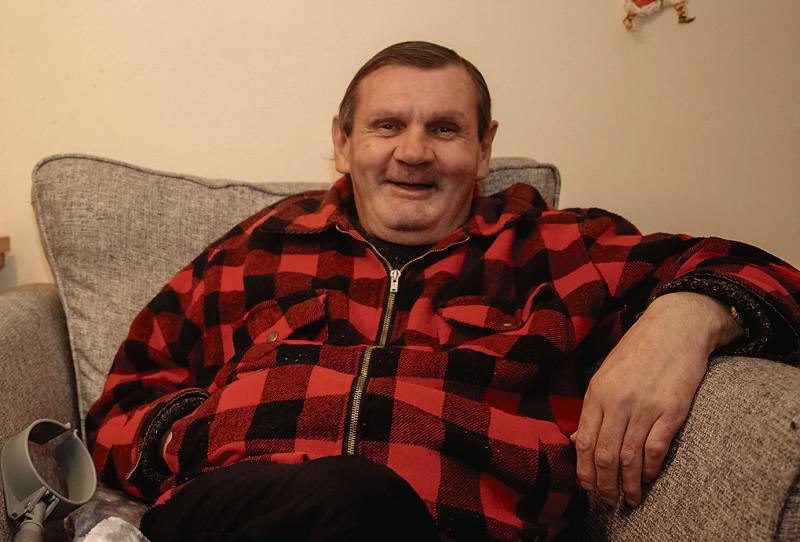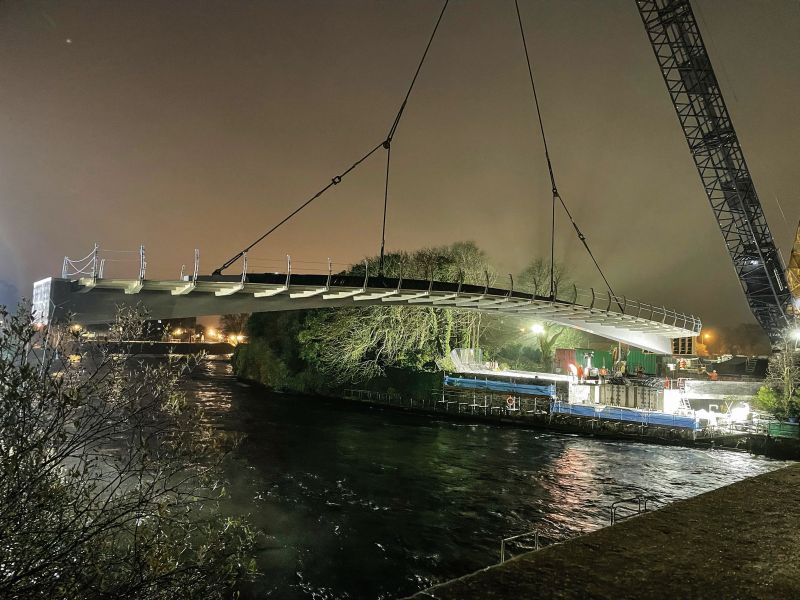CITY TRIBUNE
Well-known Galwayman becomes charity ambassador

One of Galway’s true characters has become an ambassador for the homeless charity which helped him turn his life around.
Dennis Connolly spent more than three decades on the streets of Galway battling alcoholism, which led to countless spells behind bars.
He was a regular in Judge John Garavan’s court, often for abusing passersby and breaking into shops. He previously told the Galway City Tribune he must have smashed the window at McCambridge’s around 10 times.
“There were times there that I used to have to break it to get locked up, because it was too cold. I would go in, and get the winter over.”
Dennis had known very little comfort in his younger life. Originally from Fursey Road, Shantalla, his mother died in 1959, when he was six.
Two weeks after he made his First Holy Communion, Dennis was sent to St Joseph’s Industrial School in Salthill because his father could not care for him. He remained there for nine years.
He then went to live with his aunt in the city in 1966 but was unable to settle. Despite short spells in work, he ran away to England where he first slept on the streets while still only a teenager.
He was returned home when UK authorities realised he had been reported missing. At one point he ended up being sent to St Brigid’s Psychiatric Hospital in Ballinasloe because there was nowhere else for him to go.
A brief spell with his brother Gerald in Dublin was soon followed by a pattern that would haunt his life – living rough on park benches and in doorways, in and out of hostels, while drinking himself to oblivion.
It was only after near death that he got to grips with his addiction.
On January 5, 1991, he was one of five homeless men sleeping in an abandoned van on Merchant’s Road near the Spanish Arch when a nearby 10ft wall collapsed during a storm. Minutes before he had scrambled out, pulling two of the men out behind him.
He was unable to arouse two others, Patrick “Pa” Dodd (27) and John Mongan (20), and they were crushed to death by the falling stone.
During the tragedy he had sustained broken toes which were left untreated. Eventually he was unable to get out of bed with threatened gangrene. Doctors told Dennis he would need several operations to save his legs and they would not operate unless he quit alcohol.
Faced with the prospect of losing both legs, Dennis gave up drinking on the anniversary of his mother’s death in 2004. He moved into supported accommodation run by the Galway Simon Community. Apart from some brief lapses, he has stayed sober since.
He first came into contact with Galway Simon in 1979 when some of the charity’s original volunteers visited him on their soup run.
“They were my only friends at that time. I’ll never forget how it felt to be treated like a human being, like I was worth something. At the beginning they used to come three nights a week to talk to us and bring us soup and sandwiches. Only for them I would be dead a long time ago,” he reflects.
“Back then people ignored you if you were homeless, you were kept down, you had nothing at all. I never had any possessions, only what I wore. If the shoes went, sometimes I would put cardboard in them. Christmas was the loneliest part of the year. You had nothing. You had no Christmas dinner. You never mix with anyone when you’re homeless. You’re a lonely person.”
In 2015 Dennis moved into a Council flat while still receiving support from Galway Simon.
“I’m in my own little paradise now,” he exclaims.
Dennis, who is fronting Galway Simon’s Christmas appeal, insists there are no hopeless cases.
“Look at me years ago, I changed my life and I don’t drink today. I’m years off the drink and I did it for myself. I can’t stop thinking about the people, including friends of mine, who weren’t as lucky as me. Galway Simon didn’t give up on me.”
■ Visit galwaysimon.ie to make a donation.
CITY TRIBUNE
Galway ‘masterplan’ needed to tackle housing and transport crises

From the Galway City Tribune – An impassioned plea for a ‘masterplan’ that would guide Galway City into the future has been made in the Dáil. Galway West TD Catherine Connolly stated this week that there needed to be an all-inclusive approach with “vision and leadership” in order to build a sustainable city.
Deputy Connolly spoke at length at the crisis surrounding traffic and housing in Galway city and said that not all of the blame could be laid at the door of the local authority.
She said that her preference would be the provision of light rail as the main form of public transport, but that this would have to be driven by the government.
“I sat on the local council for 17 years and despaired at all of the solutions going down one road, metaphorically and literally. In 2005 we put Park & Ride into the development plan, but that has not been rolled out. A 2016 transport strategy was outdated at the time and still has not been updated.
“Due to the housing crisis in the city, a task force was set up in 2019. Not a single report or analysis has been published on the cause of the crisis,” added Deputy Connolly.
She then referred to a report from the Land Development Agency (LDA) that identified lands suitable for the provision of housing. But she said that two-thirds of these had significant problems and a large portion was in Merlin Park University Hospital which, she said, would never have housing built on it.
In response, Minister Simon Harris spoke of the continuing job investment in the city and also in higher education, which is his portfolio.
But turning his attention to traffic congestion, he accepted that there were “real issues” when it came to transport, mobility and accessibility around Galway.
“We share the view that we need a Park & Ride facility and I understand there are also Bus Connects plans.
“I also suggest that the City Council reflect on her comments. I am proud to be in a Government that is providing unparalleled levels of investment to local authorities and unparalleled opportunities for local authorities to draw down,” he said.
Then Minister Harris referred to the controversial Galway City Outer Ring Road which he said was “struck down by An Bord Pleanála”, despite a lot of energy having been put into that project.
However, Deputy Connolly picked up on this and pointed out that An Bord Pleanála did not say ‘No’ to the ring road.
“The High Court said ‘No’ to the ring road because An Bord Pleanála acknowledged it failed utterly to consider climate change and our climate change obligations.
“That tells us something about An Bord Pleanála and the management that submitted such a plan.”
In the end, Minister Harris agreed that there needed to be a masterplan for Galway City.
“I suggest it is for the local authority to come up with a vision and then work with the Government to try to fund and implement that.”
CITY TRIBUNE
Official opening of Galway’s new pedestrian and cycle bridge

The new Salmon Weir pedestrian and cycle bridge will be officially opened to the public next Friday, May 26.
Work on the €10 million bridge got underway in April 2022, before the main structure was hoisted into place in early December.
A lunchtime tape-cutting ceremony will take place on Friday, as the first pedestrians and cyclists traverse the as-yet-unnamed bridge.
The Chief Executive of Galway City Council, Brendan McGrath, previously said the bridge, once opened, would remove existing conflicts between pedestrians, cyclists and traffic “as well as facilitating the Cross-City Link public transport corridor over the existing 200-year-old bridge”.
The naming of the new bridge has been under discussion by the Council’s Civic Commemorations Committee since late last year.
One name that has been in the mix for some time is that of the first woman in Europe to graduate with an engineering degree – Alice Perry.
Ms Perry, who was from Wellpark, graduated from Queen’s College Galway (now University of Galway) in 1906. The university’s engineering building is named in her honour.
The bridge was built by Jons Civil Engineering firm in County Meath and was assembled off-site before being transported to Galway. Funding for the project was provided in full by the National Transport Authority and the European Regional Development Fund.
(Photo: Sheila Gallagher captured the city’s new pedestrian footbridge being raised on the south side of the Salmon Weir Bridge in December. It will officially open next Friday, May 26).
CITY TRIBUNE
Minister branded ‘a disgrace’ for reversing land rezoning in Galway City

From the Galway City Tribune – Minister of State for Local Government and Planning, Kieran O’Donnell was labelled a “disgrace” for overturning councillors’ decisions to rezone land in the new City Development Plan.
Minister O’Donnell (pictured) confirmed in a letter to Council Chief Executive Brendan McGrath last week that he was reversing 25 material alternations made by councillors to the CDP 2023-29. He made the decision on the advice of Office of Planning Regulator (OPR).
Minister O’Donnell directed that 14 land parcels that were subject to land-use zoning changes by councillors as part of the Material Alterations to the Draft CDP should be reversed.
He directed that a further 11 land parcels in the city should become “unzoned”.
The Minister found that the CDP had not been made in a manner consistent with recommendations of the OPR, which required specific changes to the plan to ensure consistency with the national planning laws and guidelines.
At last week’s Council meeting Cllr Eddie Hoare (FG) asked for clarity on the process by which councillors could rezone the lands that had been changed by the Minister’s direction.
Cllr Declan McDonnell said, “What he [Minister O’Donnell] has done is an absolute disgrace”.
And he asked: “Do we have to have another development plan meeting to deal with it?”
Both Cllrs Hoare and McDonnell wondered what would become of the lands that were rezoned or unzoned by the ministerial direction.
Mr McGrath said the Council had put forward an argument in favour of retaining the material alterations in the plan, but ultimately the Minister sided with OPR.
He said if councillors want to make alterations to the new plan, they could go through the process of making a material alteration but this was lengthy.
The Save Roscam Peninsula campaign welcomed the Minister’s decision.
In a statement to the Galway City Tribune, it said the direction would mean the Roscam village area on the Roscam Peninsula will be unzoned and a number of land parcels would revert back to agriculture/high amenity.
A spokesperson for the campaign said: “the material alterations made by city councillors following lobbying by developers continued the long-standing practice of councillors facilitating a developer-led plan rather than an evidence- and policy-based plan that meets the needs of the city.
“The Minister’s direction is an important step in restoring confidence in the planning system. It is clear from the City Council’s own evidence on future housing projections that there was no requirement to zone these lands for residential purposes in order to meet the needs of the targeted population increase up to 2029,” the spokesperson added.















